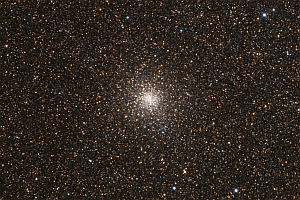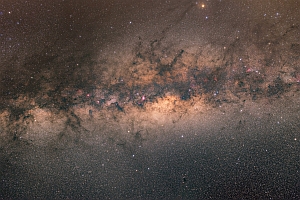Heart of Milky Way is the topic of Part #6 of our image presentation, where we want to share the results from our astrophotography-trip to the Hacienda Los Andes in Chile.
The first three images show the region around the Lagoon Nebula (Messier 8) an the Trifid Nebula (Messier 20). The Lagoon Nebula (M 8) is one of the finest and brightest star-forming regions in the sky. It is a giant cloud of interstellar matter which is currently undergoing vivid star formation, and has already formed a considerable cluster of young stars. The Trifid Nebula (M 20) is an HII region located in Sagittarius. Its name means 'divided into three lobes'. The dark nebula Barnard 85 is responsible for the trifurcated appearance of the emission nebula. The blue coloured nebula above the emission nebula is a reflection nebula.
Also visible in the images - just one degree east of M 8 - is the very beautiful region of IC 1274 and NGC 6559. IC 1274 is a faintly luminous nebula whose cavity-like morphology is reminiscent of a blistered star-forming region. NGC 6559 is the brightest part of this earea of emission and reflection nebulae, showing both emission (red) and reflection (bluish) regions.
The Eagle Nebula (M 16) is a young open cluster of stars in the constellation Serpens. The name "Eagle" refer to visual impressions of the dark silhouette near the center of the nebula, an area made famous as the "Pillars of Creation" photographed by the Hubble Space Telescope.
The Omega Nebula (M 17), also known as the Swan Nebula, Checkmark Nebula, and the Horseshoe Nebula is an H II region in the rich starfields of the Sagittarius area of the Milky Way. It lies between 5,000 and 6,000 light-years from Earth and spans some 15 light-years in diameter. The cloud of interstellar matter of which this nebula is a part is roughly 40 light-years in diameter and has a mass of 30,000 solar masses. It is considered one of the brightest and most massive star-forming regions of our galaxy!
In constellation Sagittarius we will find the Emission nebula Sh 2-37 (Gum 78) which is associated with a 130,000 solar mass giant molecular cloud and appear to be part of the Sgr OB7 association. Sh 2-37 is visible through a hole in this molecular cloud and is a very active star formation region. The two small reflection nebulae NGC 6589 and NGC 6590 are embedded in a dusty region of Sagittarius. In the neighbourhood of these two bluish nebulae we can also find a larger red emission nebula, which is named IC 1283 and IC 1284.
Still in constellation Sagittarius, there is the quite large globular cluster M 55. It was discovered by Nicolas Louis de Lacaille in 1752. M 55 is at a distance of about 17,600 light-years away from Earth and has a mass of about 269,000 times that of our Sun. Another globular cluster in Sagittarius is M 28 which was discovered by French astronomer Charles Messier in 1764. He briefly described it as a "nebula containing no star...". M 28 is at a distance of about 17,900 light-years away from Earth, has a combined 551,000 times the mass of the Sun and is approximately 12 billion years old.
Barnard's Galaxy (NGC 6822) is an irregular dwarf galaxy and a member of the Local Group. It was discovered by E. E. Barnard in 1884 with a six-inch refractor telescope. It is one of the closer galaxies to the Milky Way and is similar in structure and composition to the Small Magellanic Cloud (SMC). It's diameter is about 7,000 light-years.
The last three images are showing the Milky Way as well as the two constellations Aquila (Aql) and Scutum (Sct). The wide-field image of the Milky Way shows the area of the constellations Sagittarius (Sgr) and Scorpius (Sco). The Milky Way is at its densest near Sagittarius, because this is the region where our galactic center is located. As a result, Sagittarius contains many star clusters and nebulae. Scorpius is a large constellation located in the southern hemisphere and contains many bright stars, including Antares. It is a very prominent constellation and the Antares region is one of the most colorfull regions in the night sky!
The constellation Aquila is already related to the northern hemisphere and it lies astride the celestial equator. The alpha star, Altair, is a vertex of the well known Summer Triangle. Because of it's location along the line of our galaxy, many clusters and nebulae are found within this constellation. Unfortunately most of them are dim and there are only few galaxies. Constellation Scutum (also known as shield) was named in 1684 by Polish astronomer Johannes Hevelius (Jan Heweliusz), who originally named it Scutum Sobiescianum (Shield of Sobieski). Later, the name was shortened to Scutum. Although not a large constellation, Scutum contains several open clusters, as well as a globular cluster and a planetary nebula. The two best known deep sky objects in Scutum are M 11 (the Wild Duck Cluster) and the open cluster M 26 (NGC 6694). The globular cluster NGC 6712 and the planetary nebula IC 1295 can be found in the eastern part of the constellation, only 24 arcminutes apart.
"Stars in Chile play hide and seek" is the title of the following video made by our timelapse photographer Justin Kabaus:












